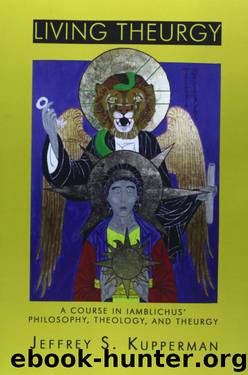Living Theurgy: A Course in Iamblichus' Philosophy, Theology and Theurgy by Jeffrey S. Kupperman

Author:Jeffrey S. Kupperman [Kupperman, Jeffrey S.]
Language: eng
Format: epub
ISBN: 9781905297719
Amazon: 1905297718
Publisher: Avalonia
Published: 2014-05-06T22:00:00+00:00
Chapter Fourteen
The Human Soul
Platonism defines a human being as a rational soul combined with a physical body. As such, Iamblichus places the human soul under the fifth Parmenidean hypothesis, which is concerned with irrational souls “woven into” rational souls.[531] Individual souls are the product of the Whole Soul via the World Soul. Iamblichus writes of the nature of the soul in his now fragmentary Peri Psyche. While Neoplatonists after Iamblichus, especially the Athenian school that produces Proclus, expand their understanding of the nature, powers, and activities of the soul, they stand upon Iamblichus’ foundation. What we see after Iamblichus is largely refinement rather than refutation.
The Soul’s Essence
All beings have essence, powers, and activities. The essence is a being’s inner-most or most fundamental self. Typically, an entity’s essence is difficult to access, or even recognize. In humanity’s case the difficulty is compounded, which is somewhat contradictory to how we might think. After all, we are humans. Shouldn’t we be able to determine our own essences?
Iamblichus,[532] following Plato and the language of the Chaldean Oracles,[533] divides humanity into three different groups. In the case of the first two, the great herd of humanity and the beginning theurgist and philosopher, the soul is combined with a body and self-identifies as that body. Only the soul of the theurgic sage is fully and experientially aware of its ultimate separateness from the body which it inhabits.
The combined nature of the human soul, of humanity, is a unique trait of a unique kind of soul. Further, this view is set in opposition to the views of earlier Neoplatonists. Plotinus teaches soul is part of the noetic realm and that part of the soul remains undescended in that realm during incarnation, forever pure and untouched by the realm of generation. Through theoria, a philosopher reunites the descended portion of the soul with the undescended. This ultimately allows us to exist in permanent contemplation of the movements of the gods in the noetic realm, never again to descend into the physical world. The entirety of this view is soundly rejected by the later Neoplatonists, based on principles of reason, cosmology, and on their need to reconcile texts such as the Phaedrus and the Timaeus.
Plotinus’ treatment of the soul is seen by the later Neoplatonists as too elevated. His view also ignores the Timaeus’ description of the soul’s creation, drawing immortal elements from the Demiurge and mortal elements from the celestial gods. Correcting this opinion, Iamblichus says the soul comes after Nous. This soul is separate from all the greater kinds and is the mean between fully immaterial, indivisible beings and fully material, divisible ones.[534] Further, the soul descends completely into a body upon incarnation, with none of it remaining out of generation.
This view provides us with some significant knowledge about the nature of the soul. First, the soul depends from the level of Nous as it extends into the psychic realm. This makes the soul distinct from, inferior to, and dependent upon the rest of the greater kinds.
Download
This site does not store any files on its server. We only index and link to content provided by other sites. Please contact the content providers to delete copyright contents if any and email us, we'll remove relevant links or contents immediately.
| Paganism | Wicca |
| Witchcraft |
Tools of Titans by Timothy Ferriss(7817)
Crystal Healing for Women by Mariah K. Lyons(7713)
The Witchcraft of Salem Village by Shirley Jackson(7041)
Inner Engineering: A Yogi's Guide to Joy by Sadhguru(6444)
The Four Agreements by Don Miguel Ruiz(6321)
The Power of Now: A Guide to Spiritual Enlightenment by Eckhart Tolle(5335)
Secrets of Antigravity Propulsion: Tesla, UFOs, and Classified Aerospace Technology by Ph.D. Paul A. Laviolette(4997)
The Wisdom of Sundays by Oprah Winfrey(4951)
Room 212 by Kate Stewart(4740)
Pale Blue Dot by Carl Sagan(4620)
Fear by Osho(4496)
The David Icke Guide to the Global Conspiracy (and how to end it) by David Icke(4384)
Rising Strong by Brene Brown(4193)
Animal Frequency by Melissa Alvarez(4156)
How to Change Your Mind by Michael Pollan(4114)
Sigil Witchery by Laura Tempest Zakroff(4030)
Real Magic by Dean Radin PhD(3926)
The Art of Happiness by The Dalai Lama(3849)
Man and His Symbols by Carl Gustav Jung(3846)
